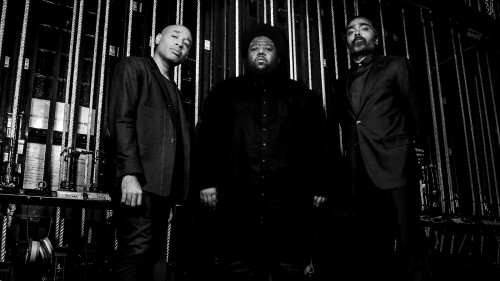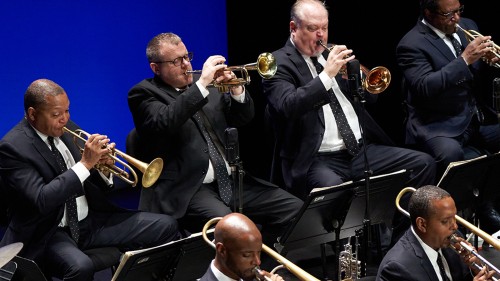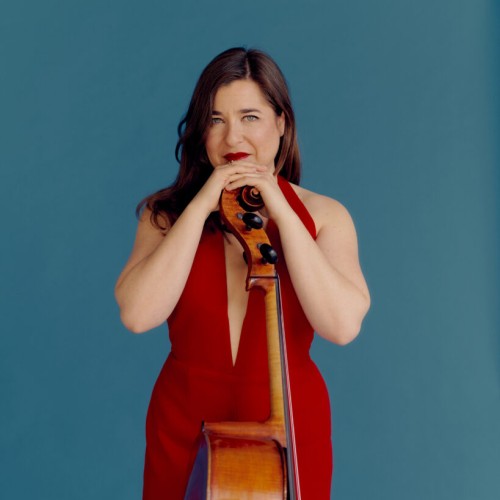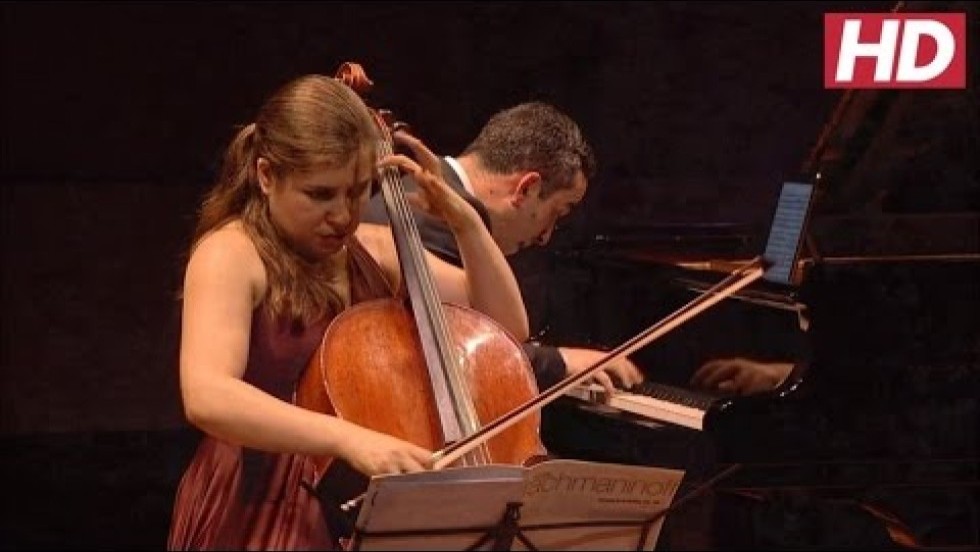
Alisa Weilerstein, cello
Inon Barnatan, piano
Cookie Notice
This site uses cookies to measure our traffic and improve your experience. By clicking "OK" you consent to our use of cookies.
Cellist Alisa Weilerstein and pianist Inon Barnatan reunite for their fourth appearance together on the Series since their joint debut in 2008. After nearly two decades of shared stages, collaborative recordings, and various other artistic projects, their profound artistic connection and heartfelt camaraderie radiate with every performance.
Their recital program masterfully pairs Brahms and Shostakovich sonatas for cello and piano with transcribed and arranged works originally written for other string instruments by the same iconic composers.
Program Details
Brahms spent many summers in the countryside away from the hustle and bustle of Vienna. The last summers of the 1870s saw him ensconced in the resort town of Pörtschach am Wörthersee in southern Austria. There he composed the Violin Sonata No. 1 concurrently with his Violin Concerto. The sonata takes its nickname, “Regensonate” (“Rain Sonata”), from Brahms’ settings of two Klaus Groth rain poems, “Regenlied” and “Nachklang.” A dotted rhythm found in both songs forms a recurring motto throughout the three movements of the sonata. Brahms hinted at this connection in a letter to a friend, writing, “you would have to have a nice, soft, rainy evening to give the proper mood.”
The dotted rhythm of Brahms’ “rain songs” appears in the initial violin melody, a serene yet wistful tune. Cascading scales like falling water pass between the instruments. Plucked strings initiate a transition into the movement’s stormy, impassioned middle. The music eventually slows and the violin reintroduces the opening melody in a minor-key; this gives way to a return of the opening material, which repeats ahead of an exuberant finish.
On a copy of the slow second movement that he presented to Clara Schumann, Brahms wrote that he composed it to “tell you, perhaps more clearly than I otherwise could myself, how sincerely I think of you and Felix.” Felix, Clara’s son, had died of tuberculosis in early 1879 at the age of 24; Brahms, who had met Clara decades earlier, had known Felix since his infancy. A gloomy funeral march reflects the pain of this recent loss. Yet Brahms manifests devotion in the outer sections of the movement whose key signature, E-flat major, had associations of intimate conversation with the divine.
The opening of the finale contains a direct quotation of Brahms’ song “Regenlied.” This restless music evokes the yearning of Groth’s text: “Cascade, rain, cascade down, / Wake for me those dreams again, / That I dreamed in childhood, / When water foamed on the sand!” Strands of melody wander about one another, coming together at last to conclude with a tranquil diminuendo.
©Andrew McIntyre, 2024
Brahms spent many summers in the countryside away from the hustle and bustle of Vienna. The last summers of the 1870s saw him ensconced in the resort town of Pörtschach am Wörthersee in southern Austria. There he composed the Violin Sonata No. 1 concurrently with his Violin Concerto. The sonata takes its nickname, “Regensonate” (“Rain Sonata”), from Brahms’ settings of two Klaus Groth rain poems, “Regenlied” and “Nachklang.” A dotted rhythm found in both songs forms a recurring motto throughout the three movements of the sonata. Brahms hinted at this connection in a letter to a friend, writing, “you would have to have a nice, soft, rainy evening to give the proper mood.”
The dotted rhythm of Brahms’ “rain songs” appears in the initial violin melody, a serene yet wistful tune. Cascading scales like falling water pass between the instruments. Plucked strings initiate a transition into the movement’s stormy, impassioned middle. The music eventually slows and the violin reintroduces the opening melody in a minor-key; this gives way to a return of the opening material, which repeats ahead of an exuberant finish.
On a copy of the slow second movement that he presented to Clara Schumann, Brahms wrote that he composed it to “tell you, perhaps more clearly than I otherwise could myself, how sincerely I think of you and Felix.” Felix, Clara’s son, had died of tuberculosis in early 1879 at the age of 24; Brahms, who had met Clara decades earlier, had known Felix since his infancy. A gloomy funeral march reflects the pain of this recent loss. Yet Brahms manifests devotion in the outer sections of the movement whose key signature, E-flat major, had associations of intimate conversation with the divine.
The opening of the finale contains a direct quotation of Brahms’ song “Regenlied.” This restless music evokes the yearning of Groth’s text: “Cascade, rain, cascade down, / Wake for me those dreams again, / That I dreamed in childhood, / When water foamed on the sand!” Strands of melody wander about one another, coming together at last to conclude with a tranquil diminuendo.
©Andrew McIntyre, 2024
Shostakovich spent his twenties establishing himself as one of the USSR’s most promising young composers. Following the premiere of his First Symphony, written at the Petrograd Conservatory, he dedicated his creative energy to composing film scores, incidental music, and works for the stage. Among these were his first operas, the satirical The Nose and Lady Macbeth of Mtsensk. Lady Macbeth premiered to resounding success, securing Shostakovich’s place (at least temporarily) at the forefront of Soviet opera. Yet these professional triumphs occurred alongside an intense crisis in his personal life.
In 1934 he began an affair that nearly ended his marriage. That summer, he fell in love with a young translator named Yelena Konstantinovskaya (coincidentally, Konstantinovskaya was denounced and arrested the following year). Shostakovich composed the Sonata over a two-week period in August of that year, during which time he and his wife Nina were temporarily separated (according to her, the two were briefly legally divorced). They reconciled, and the birth of their daughter Galina cemented their relationship until Nina’s death in the early 1950s.
The first movement opens with a lyrical main subject. Much of the music is insistent and youthful, like a young man in his prime. It stands in sharp contrast to the eerie and anemic writing found in Shostakovich’s final chamber works, which he composed at the end of a protracted decline in his health. A pizzicato passage initiates the development. The music grows agitated with increasingly dense writing for the cello. A gloomy coda appears suddenly, almost as an afterthought: the piano intones a soft but insistent accompaniment alongside a muted cello.
Muted no longer, the cello unleashes a maelstrom in the second movement. Alongside a hammering piano accompaniment, the cellist employs a variety of techniques to create a vivid palette of tone colors. Shostakovich first conceived this movement as a minuet, but his conception of the piece evolved in the decades following its completion. He later increased the tempo, transforming the movement into an energetic scherzo.
The cello is front and center in the third movement, a mournful monologue. The piano accompaniment is mostly sparse, with a pervasive three-note rhythm providing a sense of forward motion. The sonata concludes with a short, somewhat unsettling rondo.
©Andrew McIntyre, 2024
Shostakovich spent his twenties establishing himself as one of the USSR’s most promising young composers. Following the premiere of his First Symphony, written at the Petrograd Conservatory, he dedicated his creative energy to composing film scores, incidental music, and works for the stage. Among these were his first operas, the satirical The Nose and Lady Macbeth of Mtsensk. Lady Macbeth premiered to resounding success, securing Shostakovich’s place (at least temporarily) at the forefront of Soviet opera. Yet these professional triumphs occurred alongside an intense crisis in his personal life.
In 1934 he began an affair that nearly ended his marriage. That summer, he fell in love with a young translator named Yelena Konstantinovskaya (coincidentally, Konstantinovskaya was denounced and arrested the following year). Shostakovich composed the Sonata over a two-week period in August of that year, during which time he and his wife Nina were temporarily separated (according to her, the two were briefly legally divorced). They reconciled, and the birth of their daughter Galina cemented their relationship until Nina’s death in the early 1950s.
The first movement opens with a lyrical main subject. Much of the music is insistent and youthful, like a young man in his prime. It stands in sharp contrast to the eerie and anemic writing found in Shostakovich’s final chamber works, which he composed at the end of a protracted decline in his health. A pizzicato passage initiates the development. The music grows agitated with increasingly dense writing for the cello. A gloomy coda appears suddenly, almost as an afterthought: the piano intones a soft but insistent accompaniment alongside a muted cello.
Muted no longer, the cello unleashes a maelstrom in the second movement. Alongside a hammering piano accompaniment, the cellist employs a variety of techniques to create a vivid palette of tone colors. Shostakovich first conceived this movement as a minuet, but his conception of the piece evolved in the decades following its completion. He later increased the tempo, transforming the movement into an energetic scherzo.
The cello is front and center in the third movement, a mournful monologue. The piano accompaniment is mostly sparse, with a pervasive three-note rhythm providing a sense of forward motion. The sonata concludes with a short, somewhat unsettling rondo.
©Andrew McIntyre, 2024
On September 30, 1853, Robert and Clara Schumann received an obscure young composer named Johannes Brahms into their home. Robert’s diary entry from the next day includes the note, “visit from Brahms—a genius.” Brahms performed a number of his compositions for them over the next two weeks. Shortly after, in an article entitled “New Paths,” Robert heralded Brahms as one “called to give expression to his times in ideal fashion: a musician who would reveal his mastery … like Minerva springing fully armed from Kronos’s head.”
Brahms and the Schumanns quickly formed a deep bond. In Robert’s last years, Brahms visited him in the asylum where he had been institutionalized, serving as a go-between when Clara was not permitted to visit. After Robert’s death, Brahms and Clara remained close until her own passing forty years later. She bequeathed him Robert’s prized Graf piano, which Brahms used to compose the first two movements of his Cello Sonata No. 1. He composed the final movement three years later in a rented room overlooking the fir-covered mountains of the Black Forest.
The cello introduces the movement’s main theme, a sad melody low in the instrument’s range. The mood of the exposition is mercurial, moving swiftly from gentle melancholy to cheerful and then stormy. At the transition into the second section, both players repeat a descending two-note figure like a series of heavy sighs. The music grows more insistent and agitated as heavy fortissimo chords accompany slashing gestures from the cello. When the principal theme returns, the piano introduces a graceful countermelody before taking up the theme itself. The movement swells to an impassioned climax before a tranquil, major-key coda.
Brahms cast the second movement as a minuet and trio. Much of the playing is subdued, with only a handful of forte markings. The jaunty, staccato minuet concludes with plucked cello chords leading into the trio. In the trio section, a highly chromatic cello melody imbues the music with uncertainty. The movement concludes with a repeat of the minuet.
Brahms, a devotee of J. S. Bach since his childhood music lessons, based the opening theme of the finale on the penultimate fugue from Bach’s The Art of Fugue. He also employs characteristics found in the music of the Sturm und Drang (“storm and stress”) movement of the late eighteenth century: a minor key, rhythmic syncopation, sudden and extreme dynamic contrasts, fast tempos, and angular melodies with large leaps. The tempo accelerates to a gallop in the sonata’s thundering conclusion.
©Andrew McIntyre, 2024
On September 30, 1853, Robert and Clara Schumann received an obscure young composer named Johannes Brahms into their home. Robert’s diary entry from the next day includes the note, “visit from Brahms—a genius.” Brahms performed a number of his compositions for them over the next two weeks. Shortly after, in an article entitled “New Paths,” Robert heralded Brahms as one “called to give expression to his times in ideal fashion: a musician who would reveal his mastery … like Minerva springing fully armed from Kronos’s head.”
Brahms and the Schumanns quickly formed a deep bond. In Robert’s last years, Brahms visited him in the asylum where he had been institutionalized, serving as a go-between when Clara was not permitted to visit. After Robert’s death, Brahms and Clara remained close until her own passing forty years later. She bequeathed him Robert’s prized Graf piano, which Brahms used to compose the first two movements of his Cello Sonata No. 1. He composed the final movement three years later in a rented room overlooking the fir-covered mountains of the Black Forest.
The cello introduces the movement’s main theme, a sad melody low in the instrument’s range. The mood of the exposition is mercurial, moving swiftly from gentle melancholy to cheerful and then stormy. At the transition into the second section, both players repeat a descending two-note figure like a series of heavy sighs. The music grows more insistent and agitated as heavy fortissimo chords accompany slashing gestures from the cello. When the principal theme returns, the piano introduces a graceful countermelody before taking up the theme itself. The movement swells to an impassioned climax before a tranquil, major-key coda.
Brahms cast the second movement as a minuet and trio. Much of the playing is subdued, with only a handful of forte markings. The jaunty, staccato minuet concludes with plucked cello chords leading into the trio. In the trio section, a highly chromatic cello melody imbues the music with uncertainty. The movement concludes with a repeat of the minuet.
Brahms, a devotee of J. S. Bach since his childhood music lessons, based the opening theme of the finale on the penultimate fugue from Bach’s The Art of Fugue. He also employs characteristics found in the music of the Sturm und Drang (“storm and stress”) movement of the late eighteenth century: a minor key, rhythmic syncopation, sudden and extreme dynamic contrasts, fast tempos, and angular melodies with large leaps. The tempo accelerates to a gallop in the sonata’s thundering conclusion.
©Andrew McIntyre, 2024
As Shostakovich raised his nearly-useless right hand to begin composing his viola sonata, he knew that he was dying. Two years earlier he had received a diagnosis of cancer in his left lung, the latest in a series of maladies plaguing the composer that included heart attacks, a series of falls, and muscle tremors that left him barely able to hold a pen. “I must alter my psyche,” he lamented, “to the psyche of a sick man.” This mandate manifests in Shostakovich’s later works, many of which show a marked preoccupation with death.
Shostakovich composed his sole viola sonata in the summer of 1975. Perhaps he guessed that this would be his swan song, for despite his ailments he completed the sonata’s three movements in quick succession. Within weeks of finishing the first draft, Shostakovich had died, felled by respiratory seizures and another heart attack. He was sixty-eight.
Fyodor Druzhinin, violist of the Moscow-based Beethoven Quartet and Shostakovich’s advisor during the sonata’s composition, gave its first performances. The sonata was first performed in a private concert celebrating what would have been Shostakovich’s sixty-ninth birthday. A week later Druzhinin gave the public premiere in Moscow, on a program that included Shostakovich’s two sonatas for cello and violin. During the viola sonata’s intense ovation, Druzhinin solemnly held the score aloft.
Shostakovich enigmatically called the first movement a “novella.” It opens with a terse dialogue between plucked strings and an atonal, twelve-tone theme in the piano. The string “melody,” more a collection of ascending and descending leaps, weaves throughout the movement. Thin textures, angular melodic fragments, and the absence of strong harmonies create an atmosphere of unease. In the second section the music grows agitated, with driving rhythms and fortissimo chords played at the extremes of the instruments’ ranges. A thin, ethereal string passage played sul ponticello evokes the whispering of ghosts. After an extended cello solo, the movement closes with a morose, taciturn coda.
Much of the material of the second movement, a scherzo, comes from his unfinished wartime opera The Gamblers. The opening and closing galop borrows heavily from the opera’s prelude; it is followed by a shadowy, serpentine dialogue between the titular card sharks. Plucked strings evoke the balalaika, the Russian folk guitar made famous in the West by the film Doctor Zhivago.
The third movement of the sonata—and the last movement that Shostakovich would ever write—again looks backward. The piano arpeggios and the viola’s dotted rhythm directly reference Beethoven’s “Moonlight” Sonata (Shostakovich himself called this movement an “adagio in memory of Beethoven”). Its dotted funereal rhythm became a favorite of Shostakovich’s in his later years. At the core of the finale is an austere passage built upon quotations from Shostakovich’s second violin concerto and all fifteen of his symphonies in order. The sonata closes with one final backward glance: the oscillating piano gesture in the final bars borrows from the opening of Shostakovich’s Suite for two pianos in F-sharp minor, Op. 6, which he composed as a teenager in memory of his recently deceased father.
©Andrew McIntyre, 2024
As Shostakovich raised his nearly-useless right hand to begin composing his viola sonata, he knew that he was dying. Two years earlier he had received a diagnosis of cancer in his left lung, the latest in a series of maladies plaguing the composer that included heart attacks, a series of falls, and muscle tremors that left him barely able to hold a pen. “I must alter my psyche,” he lamented, “to the psyche of a sick man.” This mandate manifests in Shostakovich’s later works, many of which show a marked preoccupation with death.
Shostakovich composed his sole viola sonata in the summer of 1975. Perhaps he guessed that this would be his swan song, for despite his ailments he completed the sonata’s three movements in quick succession. Within weeks of finishing the first draft, Shostakovich had died, felled by respiratory seizures and another heart attack. He was sixty-eight.
Fyodor Druzhinin, violist of the Moscow-based Beethoven Quartet and Shostakovich’s advisor during the sonata’s composition, gave its first performances. The sonata was first performed in a private concert celebrating what would have been Shostakovich’s sixty-ninth birthday. A week later Druzhinin gave the public premiere in Moscow, on a program that included Shostakovich’s two sonatas for cello and violin. During the viola sonata’s intense ovation, Druzhinin solemnly held the score aloft.
Shostakovich enigmatically called the first movement a “novella.” It opens with a terse dialogue between plucked strings and an atonal, twelve-tone theme in the piano. The string “melody,” more a collection of ascending and descending leaps, weaves throughout the movement. Thin textures, angular melodic fragments, and the absence of strong harmonies create an atmosphere of unease. In the second section the music grows agitated, with driving rhythms and fortissimo chords played at the extremes of the instruments’ ranges. A thin, ethereal string passage played sul ponticello evokes the whispering of ghosts. After an extended cello solo, the movement closes with a morose, taciturn coda.
Much of the material of the second movement, a scherzo, comes from his unfinished wartime opera The Gamblers. The opening and closing galop borrows heavily from the opera’s prelude; it is followed by a shadowy, serpentine dialogue between the titular card sharks. Plucked strings evoke the balalaika, the Russian folk guitar made famous in the West by the film Doctor Zhivago.
The third movement of the sonata—and the last movement that Shostakovich would ever write—again looks backward. The piano arpeggios and the viola’s dotted rhythm directly reference Beethoven’s “Moonlight” Sonata (Shostakovich himself called this movement an “adagio in memory of Beethoven”). Its dotted funereal rhythm became a favorite of Shostakovich’s in his later years. At the core of the finale is an austere passage built upon quotations from Shostakovich’s second violin concerto and all fifteen of his symphonies in order. The sonata closes with one final backward glance: the oscillating piano gesture in the final bars borrows from the opening of Shostakovich’s Suite for two pianos in F-sharp minor, Op. 6, which he composed as a teenager in memory of his recently deceased father.
©Andrew McIntyre, 2024
“Weilerstein and Barnatan worked their way through the music...with impressive unanimity, precise articulation, and a feel for the narrative. ”
The Aspen Times
Featured Artists
Videos
Jordan Hall Information
This performance is generously supported by
Dorothy Altman Weber, in memory of Stephen R. Weber.
Related Events


What Makes It Great? with Rob Kapilow
Songs from My Fair Lady, Camelot, and Brigadoon: Lerner & Loewe’s Greatest Hits

Jazz at Lincoln Center Orchestra with Wynton Marsalis (2026)
Duke in Africa

Alfredo Rodriguez & Pedrito Martinez

Leif Ove Andsnes, piano

Ruckus and Davóne Tines
What is Your Hand in This?
Stay in touch with Celebrity Series of Boston and get the latest.
Email Updates Sign up for Email Updates

